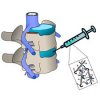Lower back pain is an all-too-common occurrence, and for many the pain is due to degenerative disc disease. The holy grail of preventing and treating disc degeneration is the use of cell therapies to restore the cushion-like functionality of the discs. The difficulty in this is that the part of the intervertebral disc (IVD) that provides much of the cushioning, the nucleus pulposa, or NP, acts much like a jelly-filled balloon; injected cells tend to leak out after just a few days, effectively rendering the therapy useless. Of course, there is also the issue of the injected cells successfully propagating once inside the NP.
Researchers at Duke University have managed to overcome both these obstacles with a new biomaterial that they’ve developed. A key component of this material is laminin, a protein found in native nucleus pulposus tissue. Laminin allows injected cells to attach and remain in place with the delivered biomaterial, survive longer, and could provide a better extracellular matrix for NP cells to grow. Also, the biomaterial is a gel that consists of three components: chemically modified laminin-111 protein and two polyethylene glycol (PEG) hydrogels. Separately, these substances are in a liquid state, but combine them like epoxy in the IVD space, and they become a gel that can hold NP cells in place.
source:medgadget.com
Biomaterial for Degenerative Disc Disease Could Reduce Back Pain and Stop Leaks

